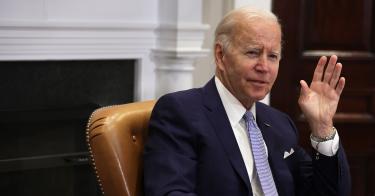In unilaterally “canceling” up to $20,000 in student loan debt for borrowers earning less than $125,000 annually, the Biden administration on Wednesday put into motion a plan that will further inflate college costs, hinder economic growth, reward upper-income earners, and provide a major handout to woke institutions of higher education.
The administration has stuck its thumb in the eye of the millions of working Americans who don’t hold college degrees but who will bear the cost of this federal largesse.
The administration is also rubbing salt in the wounds of those responsible borrowers who worked their way through college to avoid debt or who worked hard to pay off their college debt after graduating.
The millions of Americans who graduated from college, lived modestly, and did without fancy dinners and vacations so they could diligently repay the debt they agreed to pay back are surely wondering why they will get no such rebate.
Those responsible Americans are left standing there, holding the bill like chumps. They have good reason to feel insulted.
So should the Americans who eschewed college altogether because they thought it was a bad value proposition—which the Biden administration has tacitly admitted through the very move to cancel debt.
The plan is an unfair handout to Big Education, which will gladly keep raising tuition, and a politically favorable constituency of relatively wealthy, more highly educated voters.
The debt cancellation includes household income of up to $250,000, while the national median family income is only $80,000 (at best).
Biden’s boondoggle bailout will also, as Clinton-era Treasury Secretary Lawrence Summers recently pointed out, have both macro (whole-of-economy) and micro (tuition prices) inflationary effects. History demonstrates that federal subsidies have enabled colleges to raise prices with abandon. Since the 1991-92 academic year, total federal aid (including student loans and grants) increased 295%.
In response, colleges and universities more than doubled their tuition and fees in real terms.
Penn Wharton estimates the loan cancellation would cost at least $300 billion, with about 70% of the forgiveness going to the top 60% of households by income distribution. On top of that, every month federal taxpayers are losing $5 billion in accrued interest as a result of the separate, ongoing repayment moratorium.
All of this makes extending the pause on repayments Biden also announced Wednesday equally bad policy.
According to the Committee for a Responsible Federal Budget, higher-income earners, such as doctors and lawyers, benefit the most from the continued repayment pause, with law degree holders receiving an estimated $29,500 in “forgiveness” through policies like canceled interest resulting from the pause. Holders of medical degrees have received a staggering average of $48,500 in debt “cancellation” resulting from the pause.
The Committee for a Responsible Federal Budget estimates that if the pause were to continue through August 2023, doctors and lawyers would have respective total benefits of $89,500 and $54,500 per person.
Of course, those are the professionals most able to repay their student loans.
It’s true that student loan debt is high in aggregate terms. Federal student loan programs account for most of the $1.7 trillion in outstanding student loan debt. But for most borrowers, median monthly loan payments, which are $222 per month or under $2,700 per year, are manageable. If they aren’t, even better repayment options already exist.
Indeed, about half of all loans issued through the Federal Direct Loan Program are currently being repaid through income-driven repayment plans, which cap monthly loan payments based on income.
By definition, those plans are affordable. Notably, for those borrowers, the “forgiveness” scheme lopping off $10,000 (the most someone can get if he or she had no Pell grants) isn’t likely to help much at all. Low- and middle-income borrowers enrolled in income-driven repayment plans make minimal payments, and ultimate forgiveness is already baked into the plans, so lopping off $10,000 of their loan balance doesn’t actually end up being a benefit for them.
Loan forgiveness ultimately rewards the bad behavior of universities while punishing working Americans who didn’t want to—or couldn’t, for whatever reason—attain a college degree.
When colleges raise tuition, knowing that the government’s easy money will let them charge more and more, they will not plow the money into faculty salaries, but instead into, in large measure, a growing army of “diversity, equity, and inclusion” officers and other administrative busybodies.
One of the worst offenders, the University of Michigan, employs 163 people for diversity, equity, and inclusion programming and services.
As the Independent Women’s Forum’s Inez Stepman put it, the plan “robs the working class” to provide a “bailout for the woke managerial class.”
This bailout has also created intractable policy puzzles going forward. What happens to the next cohort of borrowers, currently signing on the dotted line for their student loans as the academic year begins? An older sister gets $10,000 or $20,000 off, while her younger sister does not. And the moral hazard is massive.
Students will understandably expect their loans to be forgiven going forward, and that expectation could lead to increases in borrowing and decisions to delay payment.
Past borrowers who repaid their debt have been handed an unfair bill for someone else’s loan. Future borrowers—children currently in elementary and secondary school—can expect even higher college prices as a result of this “forgiveness.”
It would be hard to design a more unfair, regressive, and inflationary policy if you tried.
This piece originally appeared in The Daily Signal



